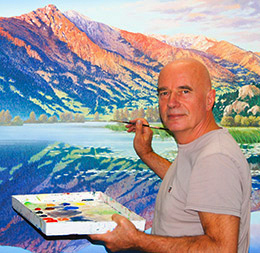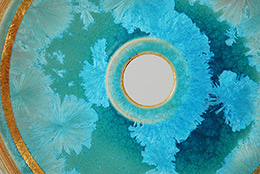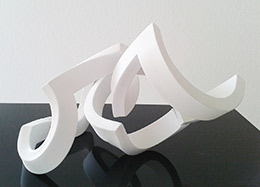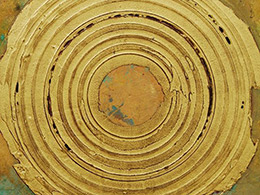The German painter and sculptor Kuno Vollet calls his recent series Creatio Continua, Continuous Creation. For these ceramic circles, he creates rough, unglazed outer edges surrounding exquisite bands of crystal glazing, which frame centers of nothingness ringed in gold. Each iconic object embodies the range of life, from manifest creation to unmanifest silence, from outer to inner to outer again, in visible form.

Creatio continua #45, ceramic with crystal glaze and gold leaf (50 cm). © Kuno Vollet
The art historian Britta Acquistapace describes these works as “an ode to life and the cosmos.” Citing Vollet’s practice of Transcendental Meditation®, Acquistapace says the artist “has found his very own impressive visual and formal language,” one that transcends foreign themes and styles. “Everything is constant transformation, without beginning, without ending,” she writes, yet his work achieves a “subtle timelessness.”
I recently spoke via Skype with Kuno Vollet in his studio in Kassel, Germany. We talked about his artistic passions, and about how his practice of TM has influenced his creative process and philosophy of art.
Two Vocations
Vollet started TM in 1970 while an art student at Kunsthochschule Kassel (Art University Kassel), where he studied painting, graphic design, and pottery. As a protégé of Werner Gnegel, a prominent international specialist in crystal glazes—an elite discipline of porcelain and ceramic glazing—Vollet laid the foundation for his later mastery of the medium.
After working as an artist for a few years, he became a TM teacher and taught from Africa to India. For a time, Vollet served as the airline steward for Maharishi Mahesh Yogi during the TM Founder’s worldwide speaking tour from 1983 to 1987. The artist brought his creative talents to decades of work with Maharishi on book design, visual arts projects, architectural design, and as principal photographer.

Kuno Vollet working on a landscape (220 cm x 120 cm, acrylic on canvas) in his Kassel studio
“Because I was having so many projects with Maharishi, you always got some new ideas, some new lessons,” Vollet remembers. Once they were viewing a sculpture someone had made of Guru Dev, Maharishi’s teacher, and Vollet says, “Maharishi wanted to dim the lights so he could better see the whole sculpture through light and shadow, its volume and beauty.”
An “Alchemist among Glazes”
Vollet returned to making his own art in 2003. “I wanted to play with my artistic life more, so I became a full-time artist again,” he said. And his career took off like a rocket. Within a few years, Vollet was exhibiting his paintings, sculptures, mobiles, and installations—which use traditional materials like gold in postmodern forms—in galleries, museums, and art fairs across Germany. In 2014 he went international, at famous expositions like ART Innsbruck in Austria and ART Expo in New York.
Vollet has been called “the alchemist among glazes,” and as a modern master of classical techniques like crystal glazing and gold-leaf, he uses pigments and metal powders like silver, copper, iron, and bronze to create stunning colors and patterns within layers of depth. With its blend of classic mastery, contemporary sensibility, and transcendent perspective, his work is in high demand.
TM and Creative Flow
Vollet is a present-day renaissance man. “Often an artist focuses on one thing—like painting sea roses, and their whole life is painting sea roses,” he laughs. “But since I’m very skillful, and I live from my art, I can do all kinds of art forms, like painting or sculpture. I also enjoy doing so many different things. Right now one of my favorites is sculpture and pottery, Creatio Continua.”

Kuno Vollet’s booth at ART Innsbruck 2016 in Austria
Practicing TM has nurtured Vollet’s effortless mastery and productivity, whether he’s doing realistic landscapes, “weightless” sculptures, multimedia collage, or ceramic forms. “TM influenced my art right from the beginning, because you have to be so relaxed, not tense when you do your work,” he explains. “When I’m doing my work, I can do it for the whole day… I get into a deeper and deeper state, and it’s just a continuous flow, where there is no disturbance. The art is just being created.”
Vollet feels that meditating also helped cultivate his responsiveness to creative impulses. “I am more relaxed, but more intuitive also,” he adds. “If I start making a painting or a sculpture, I have an idea, sometimes a very clear idea, and I’m trying to continue with this idea. But sometimes you have new things that come into the process of developing the sculpture, and so you have to just go with the flow, and then the right thing comes out… And that’s of course what TM’s all about—you go with the flow.”
“TM influenced my art right from the beginning, because you have to be so relaxed, not tense, when you do your work… I get into a deeper and deeper state, and it’s just a continuous flow, where there is no disturbance. The art is just being created.” —Kuno Vollet
Working with Gold
When Vollet was 10 or 12 years old, his parents took him to an exhibition called “Gold,” and he was captivated. Since then, he has explored this precious metal in a wide range of media, from abstract paintings to sculptures. “It’s kind of leading through my whole life, this gold!” he laughs.

Gold Works. Golden Square #7, mixed media, gold leaf on wooden panel (65 x 65 cm). © Kuno Vollet
“The radiance of gold is something which is so fascinating. I always enjoyed seeing gold in paintings from the old masters. It inspired me,” he says. “In Madonna paintings with a gold aura, they sometimes use instruments to ornament the gold with an embossing technique, which I use when I do my abstract paintings.”
As a student Vollet worked on archeological excavations, and he’s always been entranced by the ancient. He seeks “to make art that connects the past with the present. So my gold works, on one side, could be from a very old culture, but they have modern elements, too. That’s what I like, this combination of antique and modern.”
He’s also intrigued by gold’s technical and political challenges. “It’s a fine line, because it can go very quickly to looking cheap and not very deep, if you don’t handle it properly,” he notes. “And many galleries say, ‘No, no gold; we don’t want to have anything to do with gold.’ Some galleries like it, but in general, it’s a difficult subject, working with gold.”
Yet Vollet’s work in the precious metal has been embraced by art historians. Britta Acquistapace and Lena Naumann wrote the essays for Kuno Heribert Vollet: Gold Works 2003–2014 (Mundus), a book that collects and interprets Vollet’s series of abstract gold paintings as historically significant and aesthetically stunning.
The Circle and the Banyan Seed
“Before, I thought the square is the most perfect form, like in Sthapatya Veda,” Vollet says, referring to the square designs in ancient Indian architecture. And squares and rectangles are found in all his abstract gold paintings. “Then it just started happening, two and a half years ago, that I got interested in the circle,” he recalls. “I got more and more into the circle form—and now I think the circle is even more perfect and unbounded.”

Creatio Continua #33, detail, ceramic, crystal glaze, gold-leaf. © Kuno Vollet
For Vollet the circle is an iconic symbol embodying the fullness of emptiness at the basis of created form. “There’s a beautiful story which Maharishi was telling about master and disciple from some Vedic literature, with the banyan fruit,” he says, retelling the tale.
A teacher asks one of his students to bring a fruit from the banyan tree and break it open. When the student sees many seeds, the teacher asks him to break one open. “You open one layer and the next layer and the next layer, and the master is saying, ‘What comes now?’ And the disciple says, ‘There’s nothing,’ and then the master says, ‘That’s what permeates the whole creation: this emptiness of fullness,’ ” says Vollet.
“It’s like that with these objects I’m doing,” he says about his ceramic circles. “On the outer, it’s very gross. It becomes finer and finer, and then the golden area, and then in the middle, there’s nothing—that’s the most important thing.”
As the art historian Lena Naumann has written about Creatio Continua, “What is found inside the golden border is… nothing—and therefore everything! His ceramic sculptures are equally symbols of cosmic processes and of human life. However, they are compelling, not only on account of their inherent significance, but also through their great aesthetic beauty.”
Infinitum
Having worked with circular forms in two-dimensional paintings, then in the textured plane of the ceramic circles, Vollet is now breaking out of the flat plane altogether.

Vollet’s model for a brass sculpture in his Infinitum (Infinity) series (40 x 40 cm)
“I’m working now on sculptures, and I call them Infinitum. They also have this kind of round form,” he says, pausing to show me one via Skype. “It’s kind of a circle that’s bent, but it’s also continuous. They have incredible shapes. This one’s not yet cast. It’s quite a long process to make such perfect shapes, and it’s all done by hand… It’s still a circle, but it’s kind of going around and around. It’s fascinating, this new work.”
Continuous Joy
When asked what his philosophy of art is, Vollet seems reluctant to make grandiose statements, but as we talk, his philosophy emerges.
“I don’t deal with problems. I want to uplift the people when they come, because you see problems everywhere—you don’t have to go to an art fair to see all the problems!” he laughs. “I want to create something which makes people happier. And they can see it. They see the light in the work and the joy of when it was created, and how the joy also goes to the viewer.”
“I want to uplift the people when they come, because you see problems everywhere—you don’t have to go to an art fair to see all the problems! I want to create something which makes people happier.” —Kuno Vollet
Vollet’s work explores the primal circle of creation, from unmanifest to manifest, and in the process, creates another cycle between his art and the viewer. “The creation goes to the viewer, and the joy also goes to the viewer. Many say I want to have this painting because it brings me joy when I look at it,” he says.

Creatio continua #4, mixed media, gold leaf, copper, iron oxidized on wooden panel (60 x 60 cm). © Kuno Vollet
“It’s pleasing, to all the senses. It’s like a rasayana,” he adds, using the Ayurvedic term for herbs, foods, and actions that restore balance to mind and body. “When people look at something beautiful, it also does something to the psychology, to the brain, and it uplifts a person. And this is what I want to achieve with my art.”
See more of Kuno Vollet’s work at his website ►


Comments
YOU MAY ALSO LIKE
Creativity & the Arts
Lawrence Sheaff: An Artist Giving Back
Lawrence Sheaff worked with Maharishi Mahesh Yogi as a visual artist for 18 years. When he returned to his own work he wanted to combine the two things he loved most: Vedic Science and painting.
Creativity & the Arts
A Man of Steel and Silence: Jeroen Stok Sculpts Stunning Public Works
A light bulb turning on inside a character’s head indicates a brilliant idea. For Dutch artist Jeroen Stok, a light bulb was the idea that set him on his career path as a sculptor and installation artist.
Enlightenment Series
Exploring Higher States of Consciousness, the Ultimate Goal of Meditation
What is enlightenment, and what does it mean for our lives today? An in-depth interview with Dr. Craig Pearson, author of The Supreme Awakening: Experiences of Enlightenment Throughout Time—And How You Can Cultivate Them.
Creativity & the Arts
Architect Bing Thom Speaks on TM and Creativity
Bing Thom is an award-winning architect and recipient of Canada’s celebrated Golden Jubilee Medal, honoring Canadians who made a significant contribution to the nation. TM supports his work.